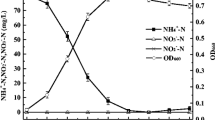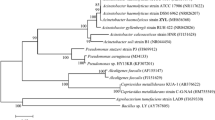Abstract
Aeration was found to affect the biological denitrification byOchrobactrum anthropi SY509. Although cell growth was vigorous under 1 vvm of aeration and an agitation speed of 400 rpm in a 3-L jar fermentor, almost no nitrate was removed. Yet under low agitation speeds (100, 200, and 300 rpm), denitrification occurred when the dissolved oxygen was exhausted shortly after the inoculation of the microorganism.Ochrobactrum anthropi SY509 was found to express highly active denitrifying enzymes under anaerobic conditions. The microorganism also synthesized denitrifying enzymes under aerobic conditions (1 vvm and 400 rpm), yet their activity was only 60% of the maximum level under anaerobic conditions and the nitrate removal efficiency was merely 15%. However, although the activities of the denitrifying enzymes were inhibited in the presence of oxygen, they were fully recovered when the conditions were switched to anaerobic conditions.
Similar content being viewed by others
References
Keith, L. H. and W. A. Telliard (1979) Priority pollutants: 1. A perspective view.Environ. Sci. Technol. 13: 416–423.
World Health Organization (1984) Guidelines for drinking water quality. Geneva, Switzerland.
National Acacdemy of Science (1978) Nitrates: An environmental assessment, Washington, DC, USA.
Mirvish, S. S. (1977) N-nitroso compounds, nitrate, and nitrite: possible implications for the causation of human cancer.Prog. Water Technol. 8: 16.
Knowles, R. (1982) Denitrification.Microbiol. Rev. 46: 43–70.
Hochstein, L. I. and G. A. Tomlinson (1988) The enzymes associated with denitrification.Annu. Rev. Microbiol. 42: 231–261.
Sung, D. W., S. H. Song, J. H. Kim, and Y. J. Yoo (2002) Effects of electron donors on nitrate removal by nitrate and nitrite reductases.Biotechnol. Bioprocess Eng. 7: 112–116.
Park, E. J., J. K. Seo, J. K. Kim, K. H. Suh, and S. K. Kim (2000) Denitrification characteristics and microorganism composition of acclimated denitrification consortium.J. Microbiol. Biotechnol. 10: 410–414.
Tirdje, J. M. (1988) Ecology of denitrification and dissimilatory nitrate reduction to ammonia. In:Biology of Anaerobic Microorganisms. Zehnder, A. J. B. (ed.), pp. 179–244. Wiley, New York, USA.
Alefounder, P. R., A. J. Gueenfield, J. E. G. McCarthy, and S. J. Ferguson (1983) Selection and organization of denitrifying electron-transfer pathway inParacoccus denitrificans.Biochim. Biophys. Acta. 724: 20–39.
Loyd D., L. Boddy, and K. J. P. Davies (1987) Persistence of bacterial denitrification capacity under aerobic conditions: the rule rather than the exception.FEMS Microb. Ecol. 45: 185–190.
Blaszczyk, M. (1993) Effect of medium composition on the denitrification of nitrate by paracoccus denitrifications.Appl. Environ. Microbiol. 59: 3951–3953.
Almeida, J. S., M. A. M. Reis, and M. J. T. Carrondo (1995) Competition between nitrate and nitrite reduction in denitrification byPseudomonas fluorescens.Biotechnol. Bioeng. 46: 476–484.
Hwang, S. H., Y. H. Lee, and M. H. Cho (1999) Isolation and characteristics of denitrifying Pseudomonas CW4.Kor. J. Biotechnol. Bioeng. 14: 616–620.
Chauret, C. and R. Knowles (1991) Effect of tungsten on nitrate and nitrite reductase inAzospirillum brasilense Sp7.Can. J. Microbiol. 37: 744–750.
McGregor, C. H. (1978) Isolation and characterization of nitrate reductase fromEscherichia coli.Methods Enzymol. 53: 347–355.
Zumft, W. G. (1997) Cell biology and molecular basis of denitrification.Microbiol. Molecular Biol. Rev. 61: 533–616.
Hewitt, L. F. (1950),Oxidation-reduction Potentials, in Bacteriology and Biochemistry. 6th ed., Livingstone, Edinburgh.
Bell, L. C., D. J. Richardson, and S. J. Ferguson (1990) Periplasmic and membrane-bound respiratory nitrate reductases inThiosphaera pantotropha.FEBS Lett. 265: 85–87.
Heather, J. S., S. J. Ferguson, D. J. Richardson, and S. Stephen (1993) The identification of a periplasmic nitrate reductase inParacoccus denitrificans.FEMS Microbiol Lett. 113: 107–112.
Author information
Authors and Affiliations
Corresponding author
Rights and permissions
About this article
Cite this article
Song, S.H., Yeom, S.H., Choi, S.S. et al. Effect of aeration on denitrification byOchrobactrum anthropi SY509. Biotechnol. Bioprocess Eng. 7, 352–356 (2002). https://doi.org/10.1007/BF02933520
Received:
Accepted:
Issue Date:
DOI: https://doi.org/10.1007/BF02933520




